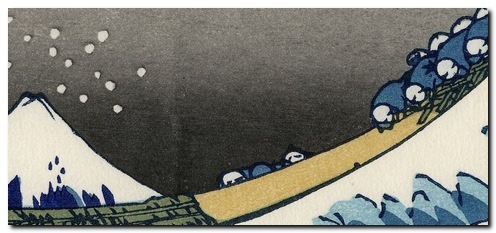The Great Wave off Kanagawa
One of the most iconic images of a Japanese woodblock print that I can think of is known as The Great Wave Off Kanagawa (Fugaku sanjurokkei: Kanagawaoki namiura) by Katsushika Hokusai (1760-1849). (Larger image link)
Copies hang in a number of international museums including The Metropolitan Museum of Art in New York City.
The movement of the wave and the boats with the small occupants is breathtaking. The bold colors and lines bring a force to the image that conveys the strength of the wave and its challengers. In the background lies Mount Fuji, almost like an imperial spectator stoically watching a game played out for its amusement.
An artist on Deviant Art using the moniker "Captain Slug" did a modern update that I absolutely love and frequently rotates on and off my desktop wallpaper.
I never really considered, however, the work that actually went into these woodblock prints. Although it looks like the artists may have just cut the lines out on a woodblock and then painted in the colors by hand - much like an ancient kid's coloring book - the truth is much more amazing to consider.
The Great Wave Reproduced
I was able to dig up a wonderful page in Japan where an artist goes through the stages used to make a modern version of that famous image by Hokusai: 葛飾北斎 | 浮世絵 | グレートウエーブ、北斎。 | HOKUSAI:Exciteエキサイトイズム.
Unfortunately, I still am unable to read Japanese or understand the spoken language, but you really don't need to do either to really enjoy clicking around the site.
What I really want to highlight is this page (Reproduct) where the artist takes us through four mini-presentations on how the blocks are cut, inked and then the final product in the reproduction.
Click on the first panel and then on the arrow-box with the characters (not the data one). You will be able to see each of the individual inked elements that make up the print when combined.
Click on the second panel and you will be able to view a brief video that shows how each woodblock is hand-cut and carved. It is very detailed and painstaking work.
Because of the potential for warpage, the blocks are carefully aged and are usually relatively small in size. Larger prints may be make up of several individual blocks, or the image itself made in a diptych or triptych form. Depending on the complexity of the image and coloring, the number of blocks can range from just a few to almost twenty.
Click on the third panel and you will be able to see another mini-video of the actual inking process for the blocks. Ink is carefully applied to its corresponding block. Depending on the artist's wishes, ink may also be applied in such a manner to create a gradient effect. In some cases, the same ink color may be used on a new block/layer to produce additional color effects.
Layers, gradients...who knew these techniques would be the forerunners to today's GIMP, Inkscape, Photoshop, and Paint.NET? Instead of carving today into woodblocks we are setting 0's and 1's crashing through microchips and charging electrons on metal platters.
More Japanese Woodblock History and Techniques
The ever handy Wikipedia has a number of great overview articles on Japanese Woodblock printing.
Woodblock printing in Japan - Wikipedia
Ukiyo-e - Wikipedia - particular technique in which glue was added to bind material into inks for bolder images.
Nishiki-e - Wikipedia - another technique in which multiple blocks were used in different areas on the image.
J. Noel Chiappa's very austere webpage has a tremendous number of fantastic Japanese woodblock items about half-way down the page.
In particular, this page, The Production of Japanese Woodblock Prints, contains a great and easy to read description of the process with remarkable illustrations of a woodblock print's color-layers. It is really wonderful and highlights the gradient and multi-color layering mentioned. Also worth looking at for the interested is the Glossary of Woodblock Print Terms that he has compiled.
A modern woodblock artist David Bull has a page on surimono albums that also contains great information and illustrations, including a page with detail images showing the different colors and textures. It's hard to imagine in our printed world but these works are actually three-dimensional, picking up the texture weave of the paper, as well as the relief from the pressing down of the paper into the carved surfaces. David also includes a page with multiple images showing the process of woodblock preparations, carving, and printing for six sets of woodblock prints. The number of stages illustrated run from just over ten to almost forty depending on the print.
Another modern woodblock artist, David Stone also offers a perspective of the process as well.
Think you have what it takes? PBS has a website where you can play with a Flash application and pick the colors for each layer of a virtual woodblock. It's much more challenging than you would imagine!
Japanese High-Resolution Woodblock Scans
What got me started on this post was a post over on Drawn! blog.
Turns out that Claremont College's Digital Library has been hard at work scanning in 289 Chikanoubu and Yoshitoshi woodblock prints and offering the images on-line.
Not only are the images themselves stunning, but the site has them categorized with subjects, titles, as well as descriptions to help viewers understand the image they are viewing.
I blew off several hours last night just on this site alone.
Sample Image: #37 Kii, Moon over the Hida River, Princess Tsuki
The aforementioned J. Noel Chiappa also has a number of nice woodblock scans from Hiroshige's 'Toto Yukimi Hakkei (8 Snow Scenes of the Eastern Metropolis)'
I hope you have found this mini-art review as fascinating and rewarding as I have.
Be artful and inspiring today!
--Claus

No comments:
Post a Comment